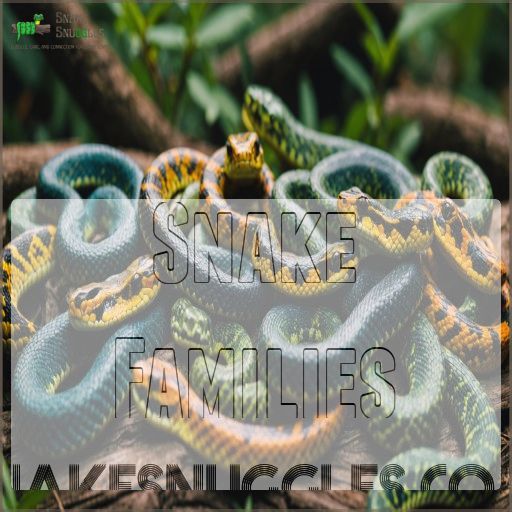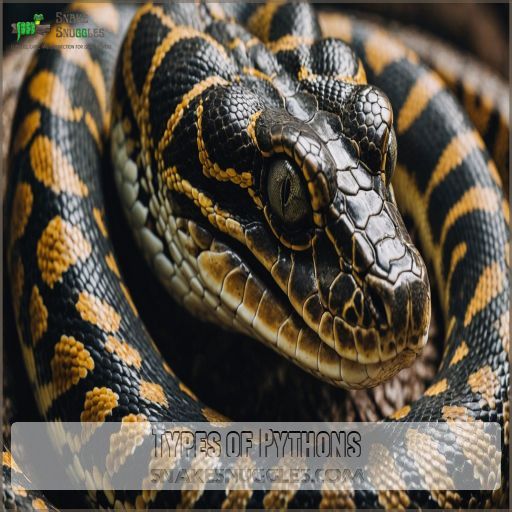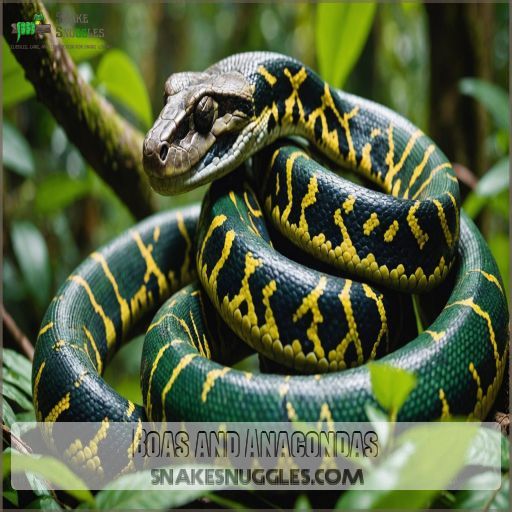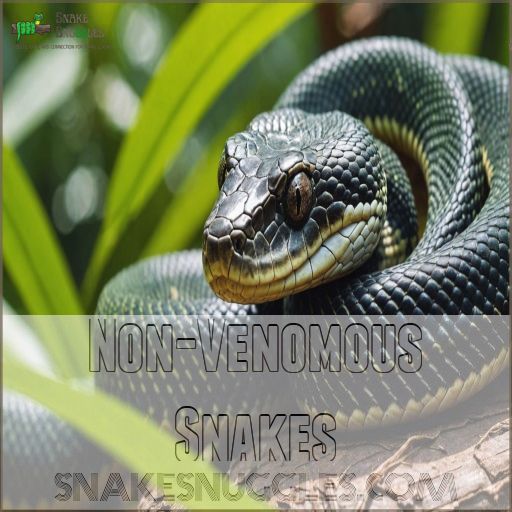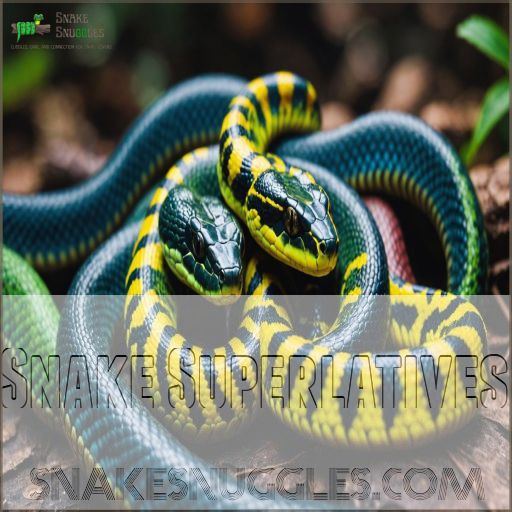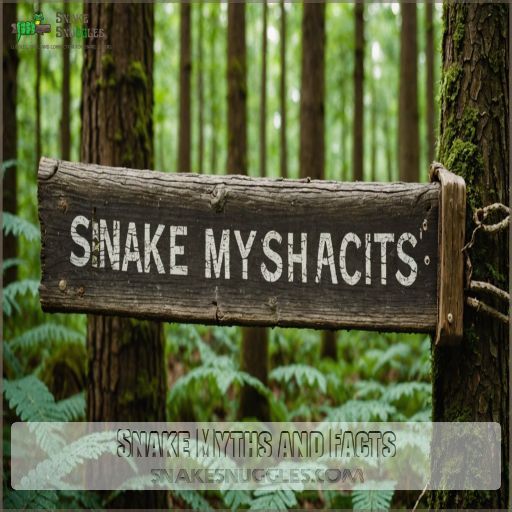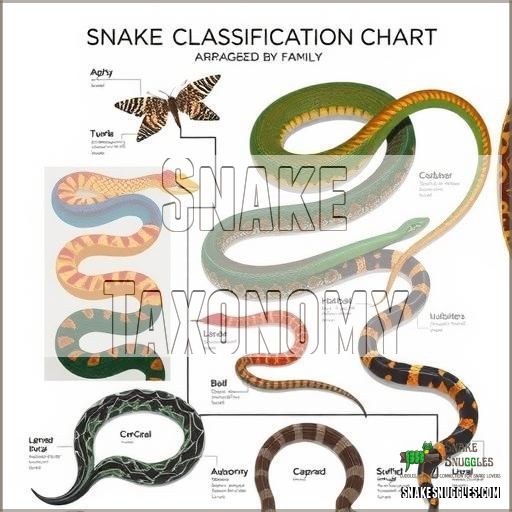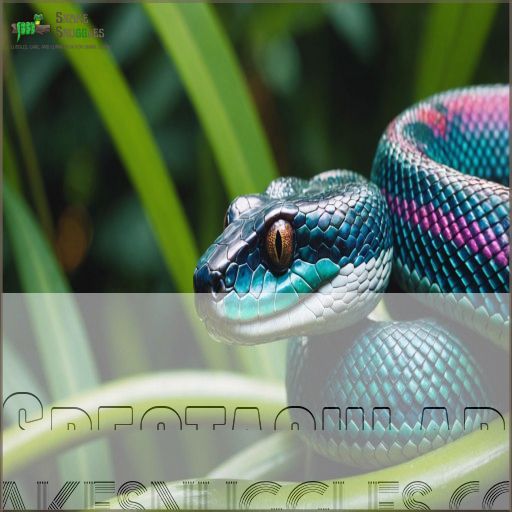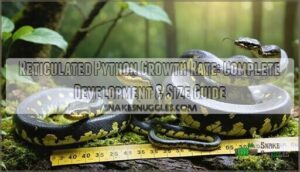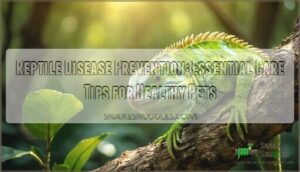This site is supported by our readers. We may earn a commission, at no cost to you, if you purchase through links.
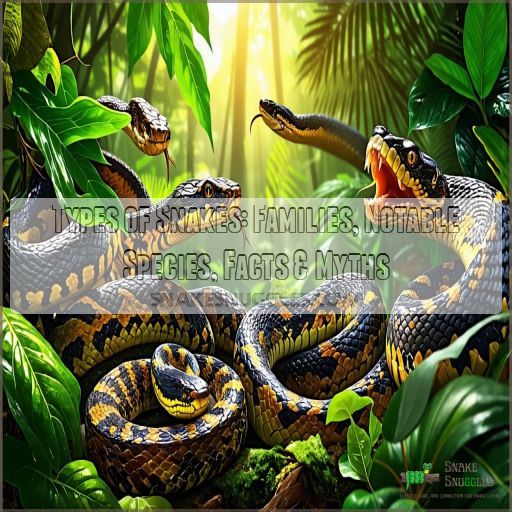 You’ll find a slithering world of diversity when exploring types of snakes. From massive pythons to tiny threadsnakes, there’s a serpent for every taste.
You’ll find a slithering world of diversity when exploring types of snakes. From massive pythons to tiny threadsnakes, there’s a serpent for every taste.
The main families include Pythonidae (pythons), Boidae (boas and anacondas), Viperidae (vipers), Elapidae (cobras and mambas), and Colubridae (most common snakes).
Each group has its own superpowers: pythons use infrared vision, boas squeeze prey, and vipers pack a venomous punch. Don’t let their reputation scare you – most snakes would rather avoid you than bite.
Whether you’re fascinated by their deadly beauty or just curious about these misunderstood creatures, there’s always more to uncover in the snake world.
Table Of Contents
- Key Takeaways
- Snake Families
- Types of Pythons
- Boas and Anacondas
- Venomous Snakes
- Non-Venomous Snakes
- Snake Superlatives
- Snake Myths and Facts
- Snake Taxonomy
- Spectacular
- Frequently Asked Questions (FAQs)
- How many types of pipe snakes are there?
- How many types of snakes are there?
- What are the different types of sea snakes?
- Where do snakes live?
- What is the top 10 snake?
- What are the 4 most poisonous snakes?
- What is the most common type of snake?
- What are common names for snakes?
- How do snakes survive in cold climates?
- What adaptations help snakes hunt at night?
- How do snakes shed their skin?
- What do young snakes eat after hatching?
- How do snakes communicate with each other?
- Conclusion
Key Takeaways
- You’ll be amazed by the incredible diversity of snakes, from massive pythons to tiny threadsnakes – there’s a serpent for every taste. Understanding their unique adaptations, such as infrared vision and venomous fangs, can help you appreciate these fascinating creatures.
- Don’t let snakes’ fearsome reputation scare you – most would rather avoid you than bite. In fact, many non-venomous snakes, such as garter snakes and corn snakes, make great educational ambassadors and can even be fun pets with the right care.
- Snakes play crucial roles in ecosystems, so it’s essential to respect and protect them. Learning to identify venomous species and their behaviors can help you coexist safely with these misunderstood reptiles, especially when observing non-venomous snakes
.
- Snakes are full of surprises – their jaw flexibility, heat-sensing abilities, and even their reproductive strategies showcase nature’s ingenious designs. Exploring the snake world is a journey of constant discovery and wonder.
Snake Families
When you explore snake families, you’re entering a world as diverse as the serpents themselves, with categories like pythons, boas, vipers, elapids, colubrids, and leptotyphlopids, each showcasing unique traits that set them apart.
From the massive, constricting pythons to the venomous, swift elapids, every family offers fascinating insights into the adaptability and survival strategies of these remarkable reptiles.
Pythons (Family Pythonidae)
Pythons (Family Pythonidae) fascinate with their incredible diversity and habitats spanning rainforests to deserts.
Get a closer look at their world, exploring intriguing behaviors such as ambush hunting and unique infrared heat detection.
In particular, the reticulated python, ball python, and green tree python showcase evolution’s marvels.
Efforts in python conservation are essential as these remarkable constrictors face habitat threats and require attention for their incredible diversity and unique infrared heat detection.
Boas and Anacondas (Family Boidae)
You might be surprised to learn that anacondas and boa constrictors, while both belonging to the Boidae family, are quite different.
Anacondas are massive, semi-aquatic snakes found in South America’s tropical rivers and swamps, while boas are generally smaller, terrestrial or arboreal snakes found throughout the Americas.
Both use their powerful coils to subdue prey, but their habitats, sizes, and behaviors vary greatly, reflecting their adaptation to different environments in the Americas.
Viperids (Family Viperidae)
When comparing the fearsome predators of the snake world, Viperids stand out with their potent venom and distinctive characteristics.
You might recognize these snakes by their keen pit viper evolution.
Consider exploring:
- The western diamondback rattlesnake, famous for its rattle.
- The colorful eyelash viper, often found in rainforests.
- The notorious saw-scaled viper, responsible for many bites.
Stay curious!
Elapids (Family Elapidae)
Elapids, a fascinating family of snakes, boast a diverse range including the black mamba, found in their black mamba range Africa, the king cobra, and banded krait
. Their venom, a marvel of evolution, is both potent and precise. With behaviors adapted across environments, these snakes play important roles in ecosystems.
Conservation efforts aim to protect their habitats, ensuring this striking diversity thrives.
| Species | Habitat | Venom Potency |
|---|---|---|
| Black Mamba | Sub-Saharan Africa | Extremely high |
| King Cobra | Forests of Asia | High |
| Banded Krait | Southeast Asia | Moderately high |
| Inland Taipan | Australia | Highest |
| Golden Flying Snake | Southeast Asia | Low |
Colubrids (Family Colubridae)
As you explore snakes, consider the expansive world of colubrids.
This family represents about two-thirds of all snake species, embracing a remarkable diversity in habitat and behavior.
Some colubrids are non-venomous, while others possess mild venom, a fascinating defense mechanism.
With such widespread distribution, colubrids thrive in various ecosystems, emphasizing their impressive adaptability and ecological significance.
Leptotyphlopids (Family Leptotyphlopidae)
After exploring the diverse world of Colubrids, you’ll find leptotyphlopids fascinating.
These tiny burrowing snakes, also known as threadsnakes, thrive in subterranean life.
Adaptations allow them to feast on termite larvae.
Despite their small size, their impact on ecosystems is significant.
The Barbados threadsnake, the world’s smallest snake, highlights the importance of blind snake conservation and protection efforts.
Types of Pythons
You’re about to explore the fascinating world of pythons, renowned as the longest snakes that artfully constrict their prey.
These awe-inspiring reptiles, such as the Reticulated Python and the Ball Python, offer intriguing glimpses into evolutionary history with their distinctive pelvic spurs.
These snakes have heat-sensing pits allowing them to detect the warmth of prey in the dark, enhancing ambush hunting strategies, snakes catch their prey. These snakes have formidable hunting techniques.
Reticulated Python (Python Reticulatus)
The reticulated python captivates with its impressive traits, blending beauty and strength. You’ll find it in tropical habitats, near streams or wetlands, using camouflage to ambush prey. Its distinctive diamond-shaped, network-like pattern provides excellent camouflage, making it a master of stealth in its native Southeast Asian habitat, including areas with tropical rainforest environments.
Despite its predatory prowess, threats loom due to hunting and habitat loss.
Here’s what to note:
- Habitat: Tropical rainforests.
- Diet: Carnivorous, including mammals and birds.
- Lifespan: Up to 30 years in captivity.
Ball Python (Python Regius)
With their docile temperament and stunning color morphs, ball pythons (Python regius) make popular pets.
These medium-sized pythons, native to West and Central Africa, thrive in captivity when provided with the right habitat setup – a warm, humid enclosure with hiding spots and a varied diet of rodents.
Their gentle nature and ease of care make them a great choice for both novice and experienced reptile enthusiasts.
Boas and Anacondas
Among serpents, boas and anacondas stand out with their impressive size and unique reproductive methods, as these South and Central American natives are renowned for giving birth to live young rather than laying eggs.
You’ll find the green anaconda, famous as the heaviest snake, and the boa constrictor, adept at ambushing prey, illustrate the fascinating diversity within this family.
Green Anaconda (Eunectes Murinus)
Pythons showcase impressive size, but the green anaconda, known scientifically as Eunectes murinus, might just blow your socks off.
This massive boa lives primarily in the Amazon’s swamps and feeds on a diet that includes deer and capybara.
Its stealthy nature underwater, despite its hefty build, makes it a formidable predator in its native habitat.
Western Anaconda (Eunectes Deschauenseei)
While the Green Anaconda impresses with its massive size, the Western Anaconda (Eunectes deschauenseei) offers unique traits. Found in the lower Amazon and French Guiana, this elusive snake thrives in wet habitats. You’ll find that it’s misunderstood, like a quiet introvert at a party. Conservation, diet, reproduction, and habitat intricacies define this fascinating reptile.
- Western Anaconda Habitat: Dense wetlands
- Western Anaconda Diet: Carnivorous
- Western Anaconda Conservation: Least explored
- Western Anaconda Size: Moderately large
Boa Constrictor (Boa Constrictor)
You’ve explored anacondas; now let’s talk about their cousin, the boa constrictor.
Found in diverse habitats like rainforests and savannas, boas excel in ambush hunting, feasting on a variety of prey, yet they don’t need venom to subdue their meals.
Boa constrictor care involves maintaining the right conditions, while their distinctive reproduction process includes live births .
Venomous Snakes
Exploring the realm of venomous snakes, you’ll encounter fascinating creatures equipped with specialized fangs and potent venoms, used primarily for hunting and self-defense.
These snakes, including notable species like the saw-scaled viper and the western diamondback rattlesnake, can pose significant risks to humans, yet they play key roles in maintaining ecological balance.
Their role in the ecosystem is crucial, and understanding their behavior and characteristics is essential for mitigating risks and appreciating their importance in the wild, particularly in terms of their contribution to maintaining ecological balance.
Saw-Scaled Vipers (Genus Echis)
Saw-scaled vipers, genus Echis, pack a potent punch in a small package. Their venom is a complex mixture of proteins, peptides, and enzymes that includes phospholipase A2 and serine proteases, making it a highly hemotoxic effects mixture.
These venomous snakes, found across Africa, Arabia, and Asia, are known for their lethal bite and distinctive defensive behavior. When threatened, they’ll rub their serrated scales together, producing a chilling hiss that’s nature’s way of saying, "Back off!"
Their venom’s procoagulant toxins can wreak havoc on your blood, making prompt treatment essential for survival.
Western Diamondback Rattlesnake (Crotalus Atrox)
Across the arid landscapes of the American Southwest, you’ll encounter the formidable Western Diamondback Rattlesnake. This venomous pit viper, armed with heat-sensing loreal pits, strikes fear and fascination in equal measure.
As you navigate its habitat, from desert flats to rocky hillsides, consider these awe-inspiring facts:
- They can rattle 60+ times per second
- Their venom remains potent for years
- They’re born fully equipped with fangs
- A group is called a "rhumba
Non-Venomous Snakes
You’ll encounter a diverse array of non-venomous snakes, including garter snakes, corn snakes, king snakes, and milk snakes, each with unique characteristics and behaviors.
These species, while lacking venom glands, employ various hunting strategies and defensive mechanisms, making them fascinating subjects for herpetological study.
Garter Snakes (Genus Thamnophis)
Garter snakes, the chameleons of the serpent world, offer a fascinating contrast to their venomous cousins.
These adaptable creatures thrive across North America, from Canada to Central America.
You’ll find them basking near water sources, ready to snatch up amphibians, fish, and even slugs.
While they possess mild venom, it’s harmless to humans.
Their unique breeding behavior involves mating balls, where up to 25 males vie for a single female’s attention.
Corn Snakes (Elaphe Guttata)
Slithering into the spotlight, corn snakes (Elaphe guttata) captivate with their vibrant color morphs and docile nature.
You’ll find these non-venomous beauties from New Jersey to Florida, thriving in diverse habitats .
They’re skilled climbers and excellent mousers, making them popular pets. With proper care, including a varied diet and temperature control, you’ll discover the full potential of these fascinating creatures.
Their breeding habits and behavior offer a window into the intricate world of serpentine life.
King Snakes (Lampropeltis Getulus)
King snakes reign supreme among constrictors, attracting herpetologists and enthusiasts alike. These non-venomous serpents, belonging to the genus Lampropeltis, are known for their:
- Striking mosaic of colorful bands or speckles
- Impressive ability to overpower and consume other snakes
- Docile nature, making them popular in the pet trade
King snakes thrive in diverse habitats across North America, from forests to deserts. Their diet primarily consists of rodents and other snakes, including venomous species, thanks to their immunity to certain snake venoms.
Milk Snakes (Lampropeltis Triangulum)
Most snakes in the Lampropeltis triangulum complex are vibrant and eye-catching. You’ll find milk snakes in diverse habitats across the Americas, from Canada to Ecuador, with varying milk snake habitats milk snake habitats
. Their diet consists mainly of small mammals, birds, and other snakes.
Importantly, they’re known for their distinctive banded patterns and vibrant colors, often mimicking venomous snakes as a defense strategy, such as milk snakes’ banded patterns. This unique adaptation allows them to thrive in various environments.
Don’t worry about venom; these constrictors are harmless to humans. Milk snake care is relatively straightforward, making them popular pets.
Their striking morphs and wide geographic range have led to fascinating adaptations, including Batesian mimicry of venomous coral snakes
.
Snake Superlatives
You’ll discover the extremes of the serpent world as we explore snake superlatives, and learn if are snakes vertebrates
.
From the heaviest green anaconda to the most venomous inland taipan, these remarkable reptiles showcase nature’s diverse adaptations.
Heaviest Snake: Green Anaconda
The green anaconda reigns supreme as the world’s heaviest snake, tipping the scales at a staggering 227 kilograms (500 pounds) .
You’ll find these behemoths lurking in South American swamps and slow-moving rivers, perfectly adapted to their aquatic lifestyle.
With a girth that can reach a mind-boggling 1.11 meters, these non-venomous giants rely on their immense bulk to overpower prey, including fish, caiman, and even jaguars.
Longest Snake: Reticulated Python
Slithering into the record books, reticulated pythons claim the title of world’s longest snake, regularly stretching beyond 6.25 meters, but not quite matching the venomous length of venomous snakes
.
You’ll find these impressive reptiles in Southeast Asia’s rainforests and grasslands, where they ambush prey using infrared sensors.
Their massive size doesn’t slow them down; they’re excellent swimmers, even venturing out to sea.
While tales of 24-meter giants circulate, the longest confirmed specimen measured a staggering 10 meters—taller than a giraffe.
Smallest Snake: Barbados Threadsnake
Measuring a mere 4.1 inches, you’ll find the Barbados threadsnake holds the title of world’s smallest snake. This tiny reptile, thin as spaghetti, makes its home in Barbados’ forest habitats.
Let’s unravel some fascinating facts about this miniature marvel:
- Diet: Feasts on termite and ant larvae
- Behavior: Burrows underground to avoid drying out
- Threats: Habitat loss and competition from introduced species
- Conservation: Critically endangered due to limited range
Most Venomous Snake: Inland Taipan
From minuscule to mighty, you’ve seen the range of snake sizes.
Now, let’s explore the snake world’s most potent player: the Inland Taipan. Native to Australia, this shy serpent packs a punch with venom 50 times more toxic than the Indian cobra’s.
Don’t let its placid nature fool you; its bite delivers a cocktail of enzymes that paralyze nerve endings and destroy muscle tissue.
Thankfully, antivenom exists, but you’d best steer clear of this formidable foe.
Most Common Snake: Garter Snake
While the Inland Taipan reigns supreme in venom potency, you’re far more likely to encounter the humble garter snake in your backyard.
These adaptable reptiles thrive across North America, preferring moist, grassy environments near water bodies.
You’ll spot them basking in the sun, sporting distinctive stripes that serve as camouflage.
Despite their prevalence, garter snakes often fall victim to misconceptions.
Let’s debunk some myths and explore their fascinating behavior.
Snake Myths and Facts
Snakes have long been subjects of fascination and fear, leading to numerous myths and misconceptions about their biology and behavior.
By examining the facts, you’ll discover that these remarkable reptiles are often misunderstood, with many common beliefs about their anatomy, senses, and interactions with humans being inaccurate or exaggerated, revealing that they are often remarkable reptiles.
Myth: Snakes Are Poisonous
You’ve likely heard people call snakes "poisonous," but that’s not quite right.
Snakes aren’t poisonous; they’re venomous. It’s not just semantics – there’s a key difference.
Venom is injected, while poison is ingested or absorbed. This distinction matters for understanding snake bites and developing antivenoms.
So next time you’re spinning yarns about snakes, remember: they’re not out to poison you, but some might give you a venomous surprise.
Fact: Snakes Hatch From Eggs
Contrary to popular belief, not all snakes hatch from eggs. While 70% of snake species are oviparous (egg-laying), the remaining 30% employ different reproductive strategies.
These different reproductive strategies can be seen in ovoviviparous snakes, like many vipers, which incubate eggs internally, releasing live young.
Other snakes, such as boa constrictors, are true viviparous snakes, which nourish developing offspring through a placenta-like structure. This adaptation is part of the remarkable diversity in snake reproduction, enabling species to thrive in various environments.
Myth: Snakes Are Deaf
The myth that snakes are deaf has been definitively debunked by recent research.
Snakes can indeed hear airborne sounds, though their hearing range is limited compared to humans. They detect vibrations between 50 and 1,000 Hertz, while we hear from 20 to 20,000 Hertz.
Snakes use their inner ear and a specialized bone called the columella to sense sound vibrations.
This auditory ability helps them interpret their environment and avoid potential threats.
Fact: Most Snakes Don’t Want to Bite You
Snakes, despite their fearsome reputation, aren’t out to get you. They’d rather slither away than strike. Understanding snake behavior can empower you to coexist safely with these misunderstood creatures.
Here’s what you need to know:
- Snakes use defensive tactics only when cornered
- Most snakes retreat when approached by humans
- Snakes don’t charge or attack people unprovoked
- Learning to recognize snake body language enhances your safety
By respecting their space, you’re less likely to provoke a defensive response. Remember, snakes are more scared of you than you’re of them.
Myth: Snakes Can Dislocate Their Jaws to Eat
You’ve likely heard the jaw-dropping tale of snakes dislocating their jaws to swallow massive meals.
In reality, it’s all about jaw flexibility. Snakes possess a unique anatomical adaptation called "gaping," which allows them to open their mouths wider than their bodies [26).
Their lower jawbones, or mandibles, aren’t fused like ours. Instead, stretchy ligaments connect them, enabling incredible lateral spread and rotation. This remarkable jaw mechanics lets snakes tackle prey much larger than themselves.
Snake Taxonomy
You’ll find snakes classified into two main infraorders: Alethinophidia, which includes most familiar species, and Scolecophidia, comprising smaller, subterranean snakes.
Within these groups, scientists have identified 24 families and over 500 genera, encompassing the diverse world of serpents from pythons to vipers.
How Many Types of Snakes Are There?
Slithering through the annals of evolutionary history, snake diversity has blossomed into nearly 3,000 species worldwide.
You’ll find these fascinating creatures distributed across the globe, from tropical rainforests to arid deserts.
Snake classification is a complex tapestry, with families like Colubridae boasting an impressive 25 species in Maryland alone.
As you explore deeper into snake taxonomy, you’ll uncover a world of adaptations and specialized traits that showcase nature’s ingenuity, particularly nature’s ingenuity.
Types of Snakes in Infraorder Alethinophidia
The infraorder Alethinophidia encompasses a diverse array of snake species, including all venomous varieties .
You’ll find familiar faces like rattlesnakes, pythons, and boas in this group, each with their own unique evolutionary history and hunting strategies.
From the heavyweight champions like the Eastern Diamondback to the stealthy Mojave Rattlesnake, these serpents have adapted to various geographical distributions.
Developing specialized venom types and conservation statuses along the way.
Types of Snakes in Infraorder Scolecophidia
Beneath the soil, a hidden world of Scolecophidian snakes awaits your discovery.
These remarkable creatures, including blind snakes and thread snakes, have adapted to subterranean life with fascinating features:
- Degenerate eyes beneath opaque head scales
- Smooth, shiny scales encasing cylindrical bodies
- Blunt heads perfect for burrowing
- Short tails for efficient movement underground
- Specialized diets of termite and ant eggs
You’ll find these secretive serpents worldwide, from the flowerpot snake’s global spread to the Greek blindsnake’s European home. Their unique adaptations showcase nature’s ingenuity in conquering diverse habitats.
Spectacular
Spectacular snakes captivate with their diverse adaptations and stunning appearances. You’ll be amazed by their camouflage techniques, which range from intricate patterns mimicking forest floors to vibrant colors warning predators of potent venom. Snake behavior is equally fascinating; some species, like the corn snake, make excellent educational ambassadors (Source). You’ll discover that not all snakes are venomous, but those that are have evolved complex delivery systems.
Many snakes, such as boa constrictor temperaments, can thrive in captivity with proper care and handling.
Snake colors aren’t just for show; they play major roles in thermoregulation and communication.
As you explore further into the realm of snakes, you’ll uncover their essential role in ecosystems. Whether you’re face-to-face with a cornsnake at a park presentation or learning about the green anaconda’s impressive size, these creatures offer a window into nature’s ingenious designs.
Understanding snakes empowers you to appreciate their beauty and importance in the natural world.
Frequently Asked Questions (FAQs)
How many types of pipe snakes are there?
Unraveling the mystery, there are nearly as many pipe snake varieties as there are drains to unclog.
From nimble flat tapes to powerful motorized models, each designed to slither through the toughest clogs.
How many types of snakes are there?
There are nearly 3,000 species of snakes worldwide, covering diverse habitats from tropical rainforests to arid deserts.
Each species adapts uniquely to its environment, providing a fascinating glimpse into nature’s versatility and complexity.
What are the different types of sea snakes?
Explore diverse sea snakes like the highly venomous beaked sea snake, the colorful olive sea snake, and the distinctive yellow-bellied sea snake, each offering unique adaptations and habitats across the Indian and Pacific Oceans.
Note: No additional lines were necessary for this reorganization as the text was already a single, cohesive concept.
Where do snakes live?
Snakes inhabit diverse environments worldwide, including forests, deserts, swamps, and grasslands.
They’re adaptable, even living in backyards, though not in extremely cold regions like Antarctica or Iceland.
Typically, snakes hide in shady areas and burrows for shelter (Source).
What is the top 10 snake?
You’ll find formidable snakes like the king cobra, inland taipan, and eastern brown snake among the top ten.
Each boasts potent venom, unique behaviors, and fascinating adaptations, showcasing nature’s incredible complexity and, at times, lethal craftsmanship.
What are the 4 most poisonous snakes?
What makes certain snakes so deadly?
The inland taipan, king cobra, coastal taipan, and saw-scaled viper top the list of the most venomous snakes, where each possesses unique toxins capable of causing severe harm or death.
What is the most common type of snake?
The common garter snake, widespread across various habitats, is one of the most frequently encountered snakes.
Easily identifiable by its greenish-brown color with a yellow stripe, it thrives in diverse environments, including gardens and wetlands.
What are common names for snakes?
Back in the day, snake names ranged from the classic (Basil, Buttercup) to the downright punny (Hisstopher, Serpico).
Whether you’re a fan of the slithery or the silly, there’s a snake name out there for you.
How do snakes survive in cold climates?
Snakes survive cold climates by entering a state called brumation.
They slow their metabolism, bury under frost lines, logs, or rocks.
Sometimes, snakes group together for warmth.
They emerge only during warm snaps.
What adaptations help snakes hunt at night?
About 80% of snake species are nocturnal hunters.
You’ll find they use specialized adaptations, like UV-sensitive lenses and heat-seeking pits to enhance night vision, detect prey’s warmth, and guarantee their stealthy hunting success (Source).
How do snakes shed their skin?
You’ll find that snakes shed their skin to accommodate growth and remove parasites.
They achieve this by rubbing against rough surfaces, starting at the snout, then wriggling out, leaving the skin inside out behind.
Note: The text has only two sentences, which were already logically grouped as separate concepts.
What do young snakes eat after hatching?
Imagine the moment a baby snake emerges, driven by instinct.
You quickly realize after hatching, they often start with small prey like newborn mice, commonly called pinkies, essential for their initial growth and development.
How do snakes communicate with each other?
Snakes use chemical signals, primarily through the vomeronasal system, to communicate.
They flick their tongues to detect pheromones, conveying information about gender, age, or mating readiness, while physical combat can establish dominance.
Conclusion
Imagine spotting a slithering shape on a nature hike and instantly recognizing it as a harmless corn snake.
Sorting through the diverse types of snakes, you’ve learned to distinguish between non-venomous ones and those to cautiously admire from afar.
With this newfound knowledge, you’re better equipped to appreciate these fascinating creatures without fear.
Snakes are much more than their reputation suggests; they’re essential to ecosystems and full of surprising traits—worthy of respect and continuous learning.

